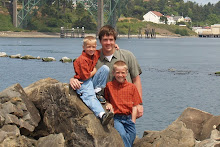1) When you are ironing your border strips, iron one set one way (i.e. toward the quilt) and one set the other way (i.e. toward the binding).

So you end up with two of each of these strips.
2) Stitch your first border on, leaving as close to exactly 1/4 inch unstitched at the beginning and end as humanly possible. If you're having a hard time figuring out whether you'll have enough fabric for the miter, fold up the corner like this to check. In this case, I'll be sewing off toward the left and the pin is marking where I want to line up the edge of the fabric. Always leave a little extra fabric!!
I line up my fabric, put my needle down one stitch past where I want to begin, do a single backstitch, then sew forward to 1/4" from the end, backstitch one stitch and clip threads. Iron borders out. Don't go crazy backstitching because you don't want a lot of thread bulk in the corner here.
3) Stitch on the next border the same way. This time if I want to know if there's enough fabric for the miter, it should look like this:
Note how the border to be sewn extends beyond the border already in place. Again, always leave a little extra.
Hopefully when you've finished sewing those two borders on you have something that looks like this:
4) Now for the miter. Take your top to a large, flat surface and fold it on the diagonal. The diagonal fold should bisect the corner tip of the quilt center, pass through the center of the seams that have just been sewn, and, in an imaginary line, extend all the way to the other corner. Now is the time to nest those border seams. I've found that if I make a good diagonal, then carefully nest the seams and line up the strips carefully, the miters turn out sharp every time. The beauty is this works well no matter how many strips you have.
Now I lay my ruler on top of the diagonal and mark that imaginary line out through the borders.
Pin carefully, especially along seam lines. Then fold down the seam joining the top to borders, pin toward the top and redraw anything that got wobbly in that last inch. Hopefully that line will meet up with your previous stitching from sewing the borders on. Sew along the line, being careful to only stitch to the seam where your borders are sewn, no farther.
Now it should look like this:
Trim the extra fabric and iron seam open from the back like this:
Now turn it over and give it a last press on top. Hopefully it looks like this:










 I also did numbers in trapunto in the single blocks in the top and bottom borders.
I also did numbers in trapunto in the single blocks in the top and bottom borders.  I was able to give it to him in person when we visited last week. He loved it, which makes me very happy.
I was able to give it to him in person when we visited last week. He loved it, which makes me very happy. 

 For the first several years after we moved here (I was in second grade), there were only two families beyond this point. There was us and there was a neighboring family who lived about 1/4 mile away over a hill. We both lived to the right, the road to the left was a largely unused, rutted, logging road. The area right behind the sign is where we had a pasture for my first horse, Twister, an 18-year-old palomino gelding. There was also one spot in particular that was the best place on the property to dig up worms for fishing. Now there's a sign to keep track of everyone and it's almost like a neighborhood in town. Most people can see at least one other house from their driveway. It got too crowded for my parents down below, so they moved farther up the mountain. They're still the last ones on the road.
For the first several years after we moved here (I was in second grade), there were only two families beyond this point. There was us and there was a neighboring family who lived about 1/4 mile away over a hill. We both lived to the right, the road to the left was a largely unused, rutted, logging road. The area right behind the sign is where we had a pasture for my first horse, Twister, an 18-year-old palomino gelding. There was also one spot in particular that was the best place on the property to dig up worms for fishing. Now there's a sign to keep track of everyone and it's almost like a neighborhood in town. Most people can see at least one other house from their driveway. It got too crowded for my parents down below, so they moved farther up the mountain. They're still the last ones on the road.  I was really excited but my dad hates the turkeys. He says they're dumber than rocks and crap all over everything to boot. I still think they must be smarter than he thinks because they know enough to make themselves scarce around mid-November.
I was really excited but my dad hates the turkeys. He says they're dumber than rocks and crap all over everything to boot. I still think they must be smarter than he thinks because they know enough to make themselves scarce around mid-November.

.jpg)